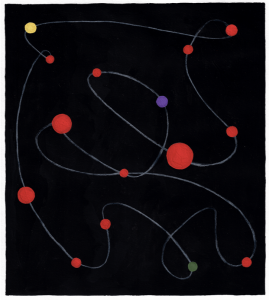Co-curators of Disobedient Objects Gavin Grindon and Catherine Flood select five highlight objects from the exhibition

There’s no party like a tea party, right? We’re not talking about right-wing conservative Republicans, we’re talking about the kind the Suffragettes held in halls and rooms across the country, where tea was poured from slogan laden teapots demanding VOTES FOR WOMEN. These objects are just one example of the paraphernalia and design objects on display at the V&A’s Disobedient Objects exhibition, investigating how political activists have employed design and creativity to agitate for change since the beginning of the 20th century.
Disobedient objects are often everyday items turned to a new purpose. This cup and saucer are the first objects seen by the visitor when entering the exhibition. They are the earliest pieces on display and are the only objects included from the V&A’s historical collection. The set represents the campaign for votes for women, and took this struggle into Edwardian drawing rooms. The Women’s Social and Political Union (WSPU) were pioneers of many protest strategies. These ranged from smashing windows in Oxford Street to designing and selling merchandise that used colours and logos to build a strong identity for the Suffragette movement. The angel trumpeteer logo was designed by Sylvia Pankhurst. Women won the right to vote nearly one hundred years ago, but other objects in the exhibition come from more recent and unresolved struggles.
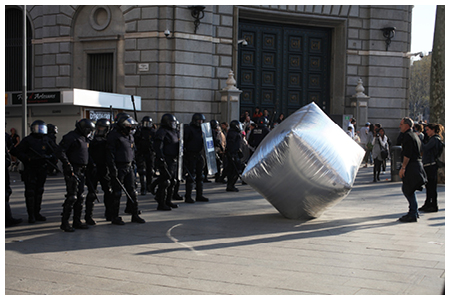
Two giant, inflated silver cobblestones hang in the Disobedient Objects exhibition. The cobblestones were used during the General Strike in Barcelona in February 2012. The clever props were thrown from the crowd and created an unusual dynamic between police and protestors. Police confronted with the objects were faced with a question; to throw them back and enter into a strange, playful game of volleyball, or attempt to destroy them. The cobblestones in this way aimed to subvert typical representations of protesters and inject a strategic frivolity into the protest.
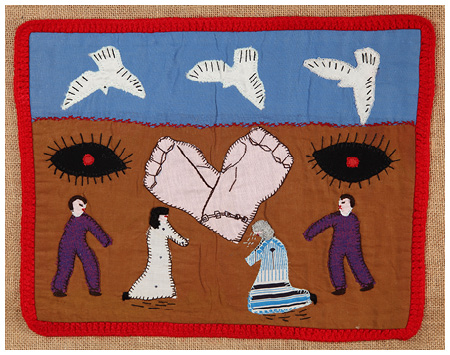
This is one of four book blocs included in Disobedient Objects. The idea originated in Italy in 2011, during student protests against severe budget cuts to public education. The protestors created cardboard and plexiglas shields decorated like books. Each shield was decorated differently, with students picking their own book design to protect and represent them. The book blocs were used to non-violently push back against police baton strikes and punches. The ‘book bloc’ idea spread like a meme. It can now be seen around the world in protests against cuts to public education and libraries.
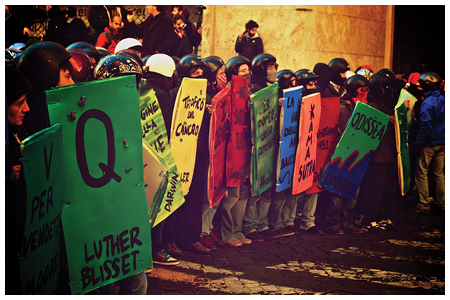
Arpilleras are appliquéd textiles that originated in Chile. Made by women, they document the violence and hardships experienced during the Pinochet dictatorship. For a time the authorities were blind to the subversive nature of the textiles, dismissing arpillera-making as folk art, and they were sold through solidarity networks abroad. Women found strength and solace in communal arpillera workshops. When their hands and eyes were focused on sewing, they felt safe enough to speak and share their stories. This arpillera shows a weeping mother, chained hands, falling doves and the penetrating eyes of the secret police. Sometimes women hid letters in the backing of arpilleras addressed to the unknown person who would buy the work. A note found tucked into the tiny pocket on the back of this arpillera shares the anguish of mothers whose loved ones have been taken away by the military.
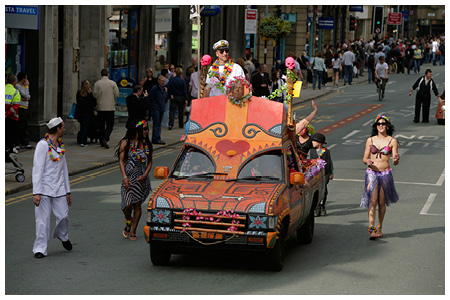
Parked in the Disobedient Objects exhibition is a pick-up truck, decorated with a multitude of mosaic tiles. Created by British artist Carrie Reichardt the truck commemorates John Joe ‘Ash’ Amador, sentenced to death by the state of Texas. After his execution, Carrie and ‘Ash’ Amador’s family took his body to a cabin in the woods where Nick Reynolds cast a death mask. Ten days later, back in Britain, the Tiki Love Truck drove through Manchester. With Ash’s mask in pride of place, it presented a spectacular statement against the death penalty.
Disobedient Objects runs until 1 February 2015, and is free to attend

